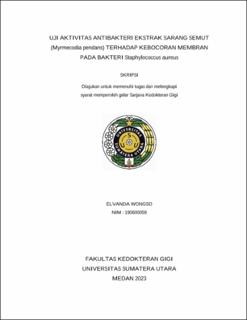| dc.description.abstract | Patients wearing fixed orthodontic appliances generally have poor oral hygiene due to difficulty in cleaning the oral cavity mechanically, causing plaque accumulation, bacteria increase, and thus higher risk of caries and periodontal disease. The use of antibacterial agent is one of the preventive measures to overcome this problem, hence the search for potential medicinal plants as antibacterial agent is rapidly increasing as the use of natural ingredients have fewer side effects and can withstand resistance compared to the use of synthetic alternatives. One of the medicinal plants that can be used as an alternative is ant-nest plant (Myrmecodia pendans). The aim of this research is to determine the effectivity of the ant-nest extract against membrane leakage of Staphylococcus aureus bacteria. The method of this research is an experimental laboratorium with Post Test Only Control Group Design. The sample of this research is ethyl acetate extract of ant-nest which was diluted using DMSO to a concentration of 0,78%, 1,56%, 3,125%, 6,25%, 12,5% and 25%, with 0.2% chlorhexidine as positive control and DMSO as negative control. The sample was incubated at 37°C for 24 hours, followed by the measurement of DNA and protein leakage using UV-vis Spectrophotometer and the measurement of calcium and potassium metals leakage using Atomic Absorption Spectrophotometer. The result of the study shows that the most effective concentration in causing DNA, protein, calcium, and potassium metal leakage on the treatment group is the group of ethyl acetate extract from the ant-nest with a concentration of 25%, resulting in the mean and standard deviation of 0.261 ± 0.016, 0.430 ± 0.018, 0.549 ± 0.000, and 0.508 ± 0.000 consecutively. Data of DNA, protein, calcium and potassium leakage were then statistically analyzed using one way ANOVA and Kruskal-Wallis test, which showed p values less than 0.05 and considered as a significant difference in all groups. Based on this research, it can be concluded that the ant-nest (Myrmecodia pendans) extract has antibacterial activity that could cause membrane leakage against Staphylococcus aureus. | en_US |

